Murdoch University BUS267 Work Based Learning Learning Log
VerifiedAdded on 2022/11/25
|6
|1530
|291
Homework Assignment
AI Summary
This assignment is a learning log submitted by a student for the BUS267 Work Based Learning course. It delves into several key topics, including change management, corporate governance, ethics and values, and corporate social responsibility (CSR) within the workplace. The student reflects on their practical experiences as an HR executive, comparing academic theories with real-world applications. The assignment covers how change management was implemented in recruitment and HR practices, the application of corporate governance to improve a company's image, the importance of ethics and values in addressing workplace discrimination, and the impact of CSR initiatives on a company's revenue and stakeholder relations. The student highlights the differences between theoretical knowledge and practical implementation, emphasizing the importance of market research, budgeting, employee engagement, energy audits, stakeholder communication, and persuasive communication skills. References to relevant academic sources are also included. The assignment provides a valuable overview of how these concepts function in a business environment and the challenges faced.
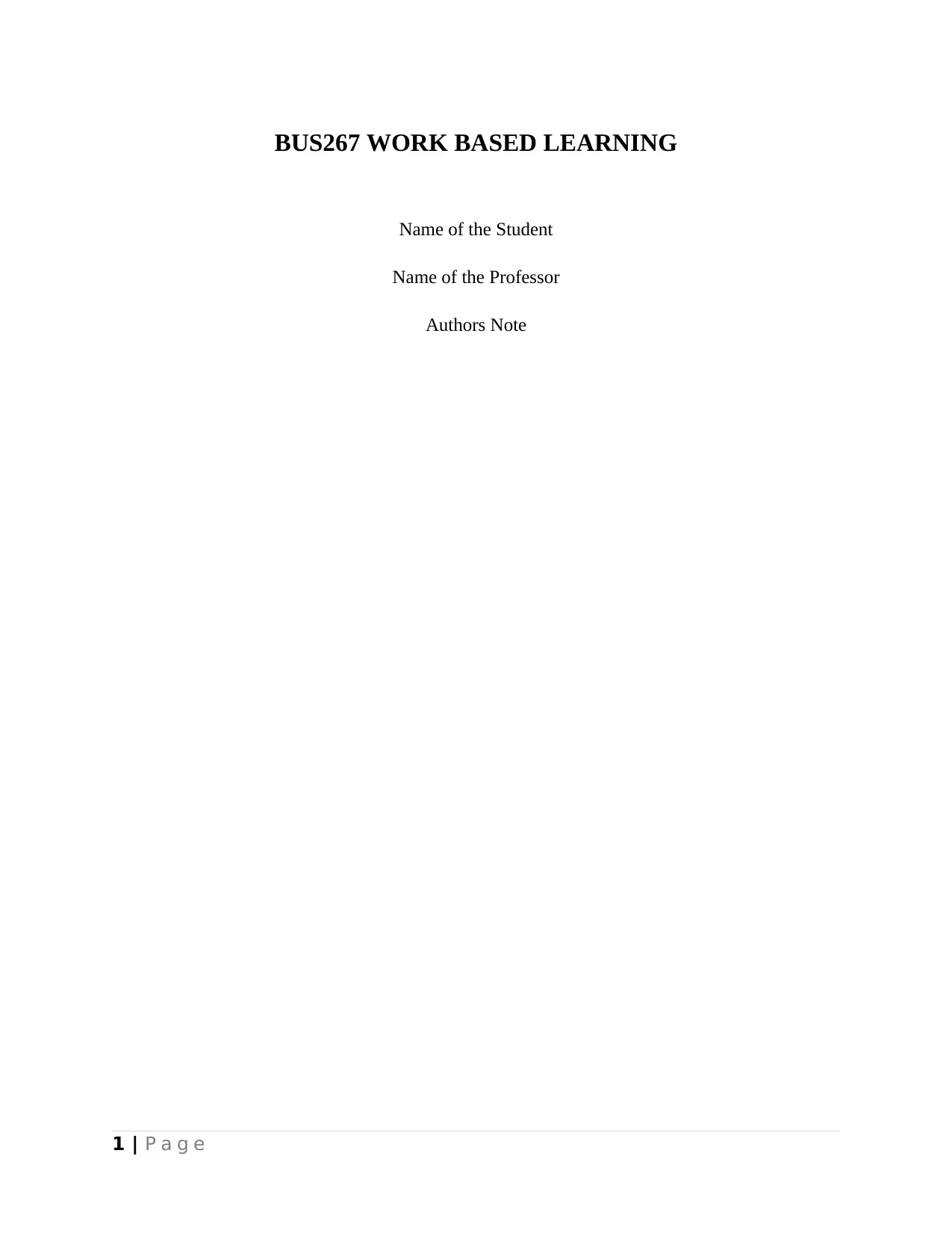
BUS267 WORK BASED LEARNING
Name of the Student
Name of the Professor
Authors Note
1 | P a g e
Name of the Student
Name of the Professor
Authors Note
1 | P a g e
Paraphrase This Document
Need a fresh take? Get an instant paraphrase of this document with our AI Paraphraser
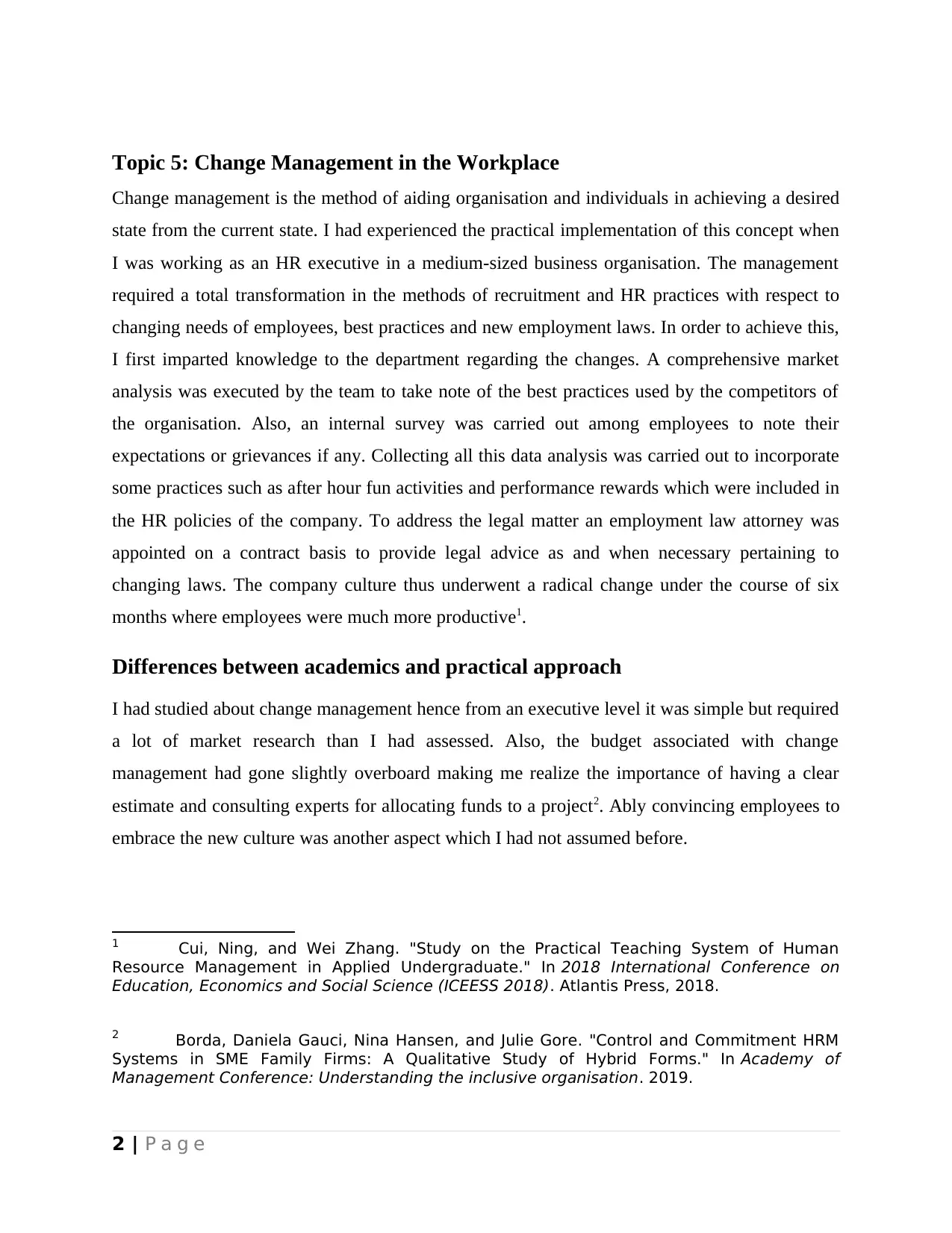
Topic 5: Change Management in the Workplace
Change management is the method of aiding organisation and individuals in achieving a desired
state from the current state. I had experienced the practical implementation of this concept when
I was working as an HR executive in a medium-sized business organisation. The management
required a total transformation in the methods of recruitment and HR practices with respect to
changing needs of employees, best practices and new employment laws. In order to achieve this,
I first imparted knowledge to the department regarding the changes. A comprehensive market
analysis was executed by the team to take note of the best practices used by the competitors of
the organisation. Also, an internal survey was carried out among employees to note their
expectations or grievances if any. Collecting all this data analysis was carried out to incorporate
some practices such as after hour fun activities and performance rewards which were included in
the HR policies of the company. To address the legal matter an employment law attorney was
appointed on a contract basis to provide legal advice as and when necessary pertaining to
changing laws. The company culture thus underwent a radical change under the course of six
months where employees were much more productive1.
Differences between academics and practical approach
I had studied about change management hence from an executive level it was simple but required
a lot of market research than I had assessed. Also, the budget associated with change
management had gone slightly overboard making me realize the importance of having a clear
estimate and consulting experts for allocating funds to a project2. Ably convincing employees to
embrace the new culture was another aspect which I had not assumed before.
1 Cui, Ning, and Wei Zhang. "Study on the Practical Teaching System of Human
Resource Management in Applied Undergraduate." In 2018 International Conference on
Education, Economics and Social Science (ICEESS 2018). Atlantis Press, 2018.
2 Borda, Daniela Gauci, Nina Hansen, and Julie Gore. "Control and Commitment HRM
Systems in SME Family Firms: A Qualitative Study of Hybrid Forms." In Academy of
Management Conference: Understanding the inclusive organisation. 2019.
2 | P a g e
Change management is the method of aiding organisation and individuals in achieving a desired
state from the current state. I had experienced the practical implementation of this concept when
I was working as an HR executive in a medium-sized business organisation. The management
required a total transformation in the methods of recruitment and HR practices with respect to
changing needs of employees, best practices and new employment laws. In order to achieve this,
I first imparted knowledge to the department regarding the changes. A comprehensive market
analysis was executed by the team to take note of the best practices used by the competitors of
the organisation. Also, an internal survey was carried out among employees to note their
expectations or grievances if any. Collecting all this data analysis was carried out to incorporate
some practices such as after hour fun activities and performance rewards which were included in
the HR policies of the company. To address the legal matter an employment law attorney was
appointed on a contract basis to provide legal advice as and when necessary pertaining to
changing laws. The company culture thus underwent a radical change under the course of six
months where employees were much more productive1.
Differences between academics and practical approach
I had studied about change management hence from an executive level it was simple but required
a lot of market research than I had assessed. Also, the budget associated with change
management had gone slightly overboard making me realize the importance of having a clear
estimate and consulting experts for allocating funds to a project2. Ably convincing employees to
embrace the new culture was another aspect which I had not assumed before.
1 Cui, Ning, and Wei Zhang. "Study on the Practical Teaching System of Human
Resource Management in Applied Undergraduate." In 2018 International Conference on
Education, Economics and Social Science (ICEESS 2018). Atlantis Press, 2018.
2 Borda, Daniela Gauci, Nina Hansen, and Julie Gore. "Control and Commitment HRM
Systems in SME Family Firms: A Qualitative Study of Hybrid Forms." In Academy of
Management Conference: Understanding the inclusive organisation. 2019.
2 | P a g e
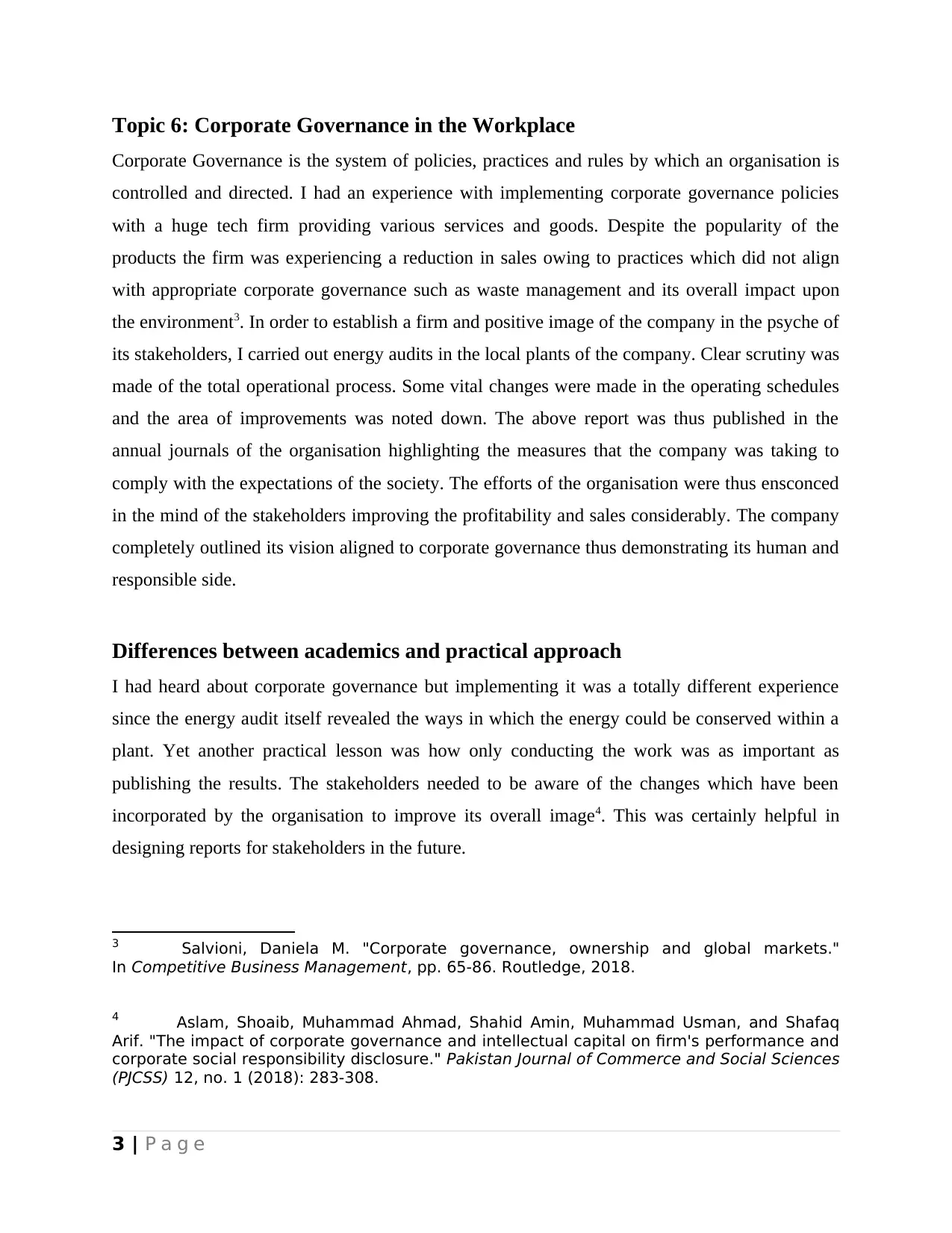
Topic 6: Corporate Governance in the Workplace
Corporate Governance is the system of policies, practices and rules by which an organisation is
controlled and directed. I had an experience with implementing corporate governance policies
with a huge tech firm providing various services and goods. Despite the popularity of the
products the firm was experiencing a reduction in sales owing to practices which did not align
with appropriate corporate governance such as waste management and its overall impact upon
the environment3. In order to establish a firm and positive image of the company in the psyche of
its stakeholders, I carried out energy audits in the local plants of the company. Clear scrutiny was
made of the total operational process. Some vital changes were made in the operating schedules
and the area of improvements was noted down. The above report was thus published in the
annual journals of the organisation highlighting the measures that the company was taking to
comply with the expectations of the society. The efforts of the organisation were thus ensconced
in the mind of the stakeholders improving the profitability and sales considerably. The company
completely outlined its vision aligned to corporate governance thus demonstrating its human and
responsible side.
Differences between academics and practical approach
I had heard about corporate governance but implementing it was a totally different experience
since the energy audit itself revealed the ways in which the energy could be conserved within a
plant. Yet another practical lesson was how only conducting the work was as important as
publishing the results. The stakeholders needed to be aware of the changes which have been
incorporated by the organisation to improve its overall image4. This was certainly helpful in
designing reports for stakeholders in the future.
3 Salvioni, Daniela M. "Corporate governance, ownership and global markets."
In Competitive Business Management, pp. 65-86. Routledge, 2018.
4 Aslam, Shoaib, Muhammad Ahmad, Shahid Amin, Muhammad Usman, and Shafaq
Arif. "The impact of corporate governance and intellectual capital on firm's performance and
corporate social responsibility disclosure." Pakistan Journal of Commerce and Social Sciences
(PJCSS) 12, no. 1 (2018): 283-308.
3 | P a g e
Corporate Governance is the system of policies, practices and rules by which an organisation is
controlled and directed. I had an experience with implementing corporate governance policies
with a huge tech firm providing various services and goods. Despite the popularity of the
products the firm was experiencing a reduction in sales owing to practices which did not align
with appropriate corporate governance such as waste management and its overall impact upon
the environment3. In order to establish a firm and positive image of the company in the psyche of
its stakeholders, I carried out energy audits in the local plants of the company. Clear scrutiny was
made of the total operational process. Some vital changes were made in the operating schedules
and the area of improvements was noted down. The above report was thus published in the
annual journals of the organisation highlighting the measures that the company was taking to
comply with the expectations of the society. The efforts of the organisation were thus ensconced
in the mind of the stakeholders improving the profitability and sales considerably. The company
completely outlined its vision aligned to corporate governance thus demonstrating its human and
responsible side.
Differences between academics and practical approach
I had heard about corporate governance but implementing it was a totally different experience
since the energy audit itself revealed the ways in which the energy could be conserved within a
plant. Yet another practical lesson was how only conducting the work was as important as
publishing the results. The stakeholders needed to be aware of the changes which have been
incorporated by the organisation to improve its overall image4. This was certainly helpful in
designing reports for stakeholders in the future.
3 Salvioni, Daniela M. "Corporate governance, ownership and global markets."
In Competitive Business Management, pp. 65-86. Routledge, 2018.
4 Aslam, Shoaib, Muhammad Ahmad, Shahid Amin, Muhammad Usman, and Shafaq
Arif. "The impact of corporate governance and intellectual capital on firm's performance and
corporate social responsibility disclosure." Pakistan Journal of Commerce and Social Sciences
(PJCSS) 12, no. 1 (2018): 283-308.
3 | P a g e
⊘ This is a preview!⊘
Do you want full access?
Subscribe today to unlock all pages.

Trusted by 1+ million students worldwide
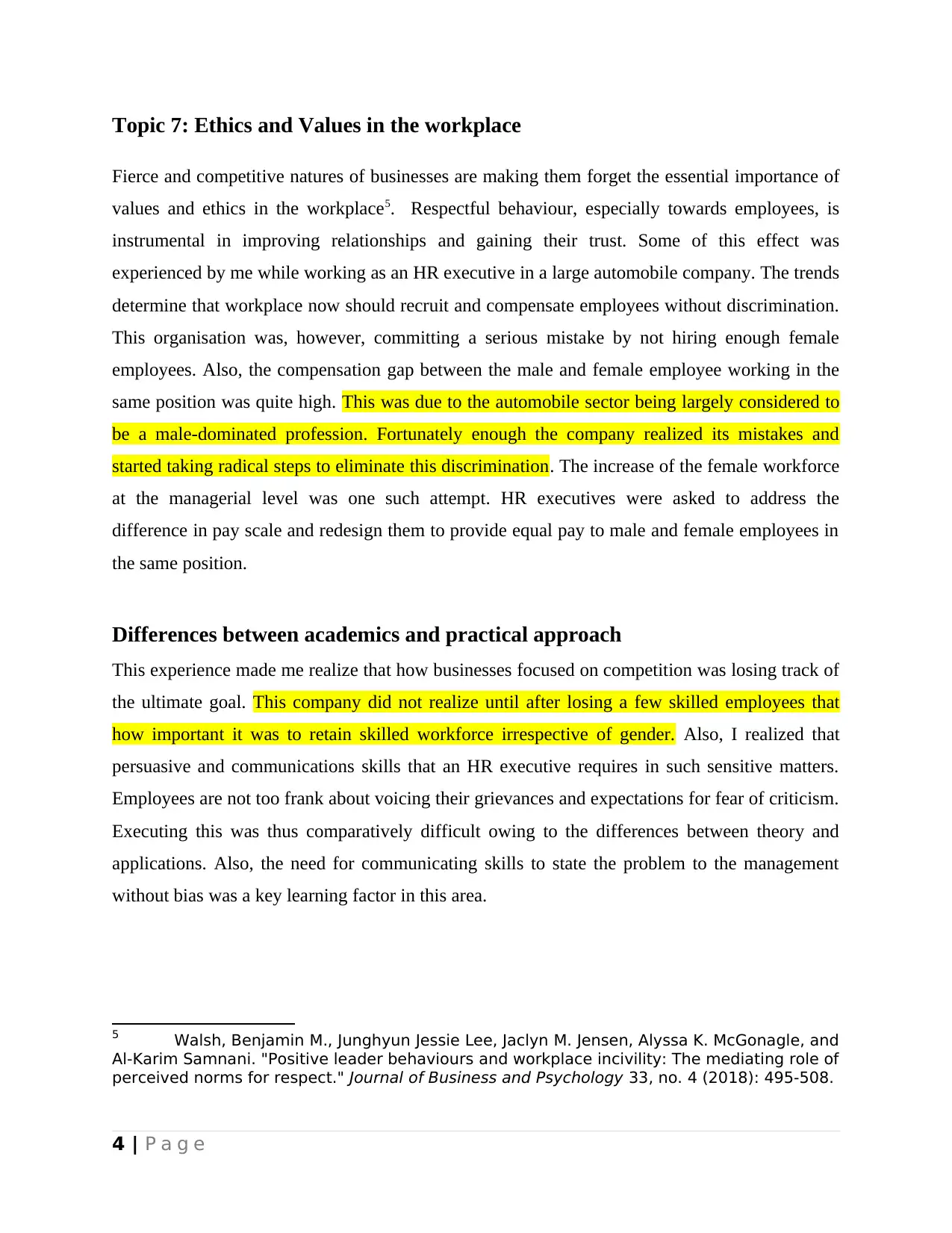
Topic 7: Ethics and Values in the workplace
Fierce and competitive natures of businesses are making them forget the essential importance of
values and ethics in the workplace5. Respectful behaviour, especially towards employees, is
instrumental in improving relationships and gaining their trust. Some of this effect was
experienced by me while working as an HR executive in a large automobile company. The trends
determine that workplace now should recruit and compensate employees without discrimination.
This organisation was, however, committing a serious mistake by not hiring enough female
employees. Also, the compensation gap between the male and female employee working in the
same position was quite high. This was due to the automobile sector being largely considered to
be a male-dominated profession. Fortunately enough the company realized its mistakes and
started taking radical steps to eliminate this discrimination. The increase of the female workforce
at the managerial level was one such attempt. HR executives were asked to address the
difference in pay scale and redesign them to provide equal pay to male and female employees in
the same position.
Differences between academics and practical approach
This experience made me realize that how businesses focused on competition was losing track of
the ultimate goal. This company did not realize until after losing a few skilled employees that
how important it was to retain skilled workforce irrespective of gender. Also, I realized that
persuasive and communications skills that an HR executive requires in such sensitive matters.
Employees are not too frank about voicing their grievances and expectations for fear of criticism.
Executing this was thus comparatively difficult owing to the differences between theory and
applications. Also, the need for communicating skills to state the problem to the management
without bias was a key learning factor in this area.
5 Walsh, Benjamin M., Junghyun Jessie Lee, Jaclyn M. Jensen, Alyssa K. McGonagle, and
Al-Karim Samnani. "Positive leader behaviours and workplace incivility: The mediating role of
perceived norms for respect." Journal of Business and Psychology 33, no. 4 (2018): 495-508.
4 | P a g e
Fierce and competitive natures of businesses are making them forget the essential importance of
values and ethics in the workplace5. Respectful behaviour, especially towards employees, is
instrumental in improving relationships and gaining their trust. Some of this effect was
experienced by me while working as an HR executive in a large automobile company. The trends
determine that workplace now should recruit and compensate employees without discrimination.
This organisation was, however, committing a serious mistake by not hiring enough female
employees. Also, the compensation gap between the male and female employee working in the
same position was quite high. This was due to the automobile sector being largely considered to
be a male-dominated profession. Fortunately enough the company realized its mistakes and
started taking radical steps to eliminate this discrimination. The increase of the female workforce
at the managerial level was one such attempt. HR executives were asked to address the
difference in pay scale and redesign them to provide equal pay to male and female employees in
the same position.
Differences between academics and practical approach
This experience made me realize that how businesses focused on competition was losing track of
the ultimate goal. This company did not realize until after losing a few skilled employees that
how important it was to retain skilled workforce irrespective of gender. Also, I realized that
persuasive and communications skills that an HR executive requires in such sensitive matters.
Employees are not too frank about voicing their grievances and expectations for fear of criticism.
Executing this was thus comparatively difficult owing to the differences between theory and
applications. Also, the need for communicating skills to state the problem to the management
without bias was a key learning factor in this area.
5 Walsh, Benjamin M., Junghyun Jessie Lee, Jaclyn M. Jensen, Alyssa K. McGonagle, and
Al-Karim Samnani. "Positive leader behaviours and workplace incivility: The mediating role of
perceived norms for respect." Journal of Business and Psychology 33, no. 4 (2018): 495-508.
4 | P a g e
Paraphrase This Document
Need a fresh take? Get an instant paraphrase of this document with our AI Paraphraser
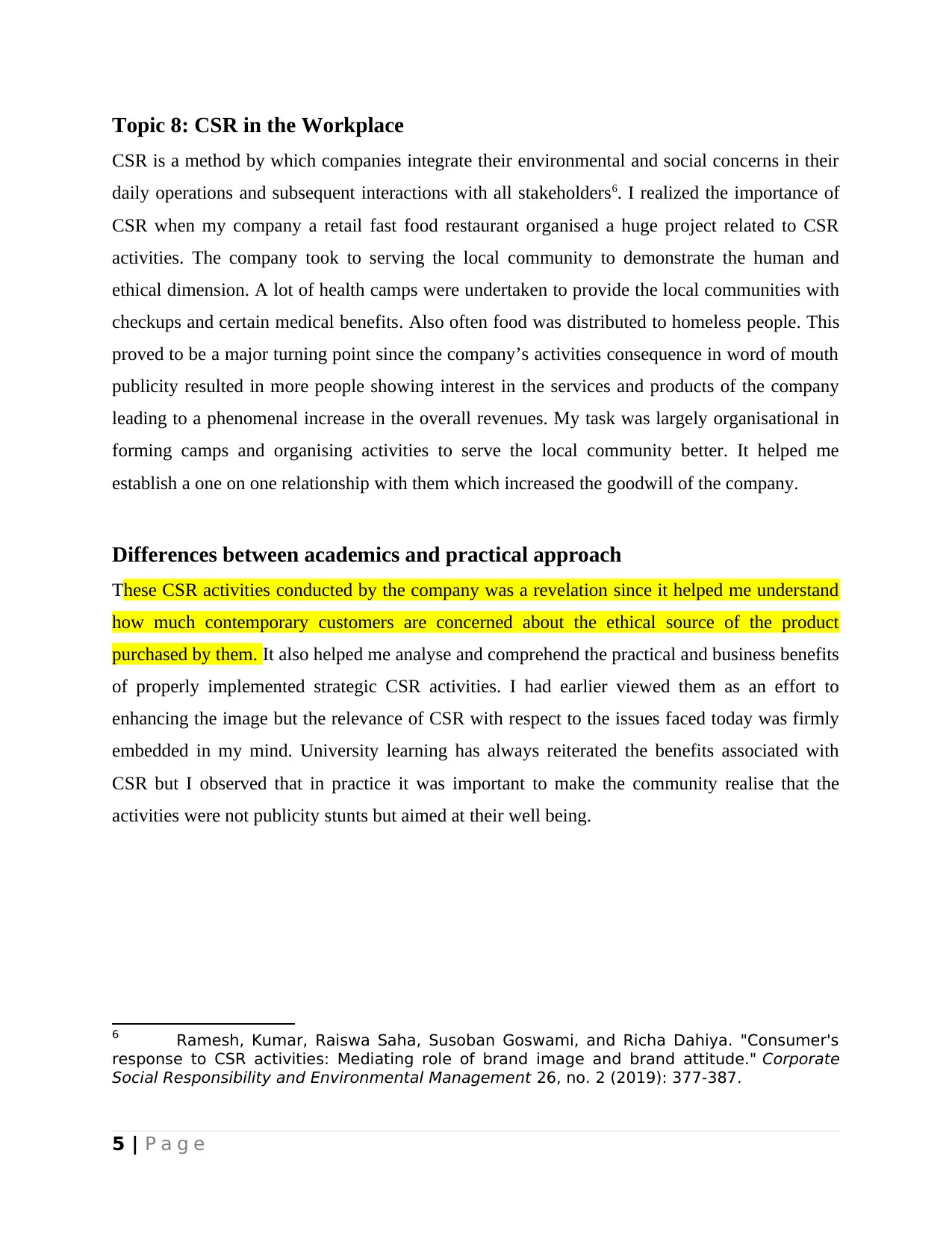
Topic 8: CSR in the Workplace
CSR is a method by which companies integrate their environmental and social concerns in their
daily operations and subsequent interactions with all stakeholders6. I realized the importance of
CSR when my company a retail fast food restaurant organised a huge project related to CSR
activities. The company took to serving the local community to demonstrate the human and
ethical dimension. A lot of health camps were undertaken to provide the local communities with
checkups and certain medical benefits. Also often food was distributed to homeless people. This
proved to be a major turning point since the company’s activities consequence in word of mouth
publicity resulted in more people showing interest in the services and products of the company
leading to a phenomenal increase in the overall revenues. My task was largely organisational in
forming camps and organising activities to serve the local community better. It helped me
establish a one on one relationship with them which increased the goodwill of the company.
Differences between academics and practical approach
These CSR activities conducted by the company was a revelation since it helped me understand
how much contemporary customers are concerned about the ethical source of the product
purchased by them. It also helped me analyse and comprehend the practical and business benefits
of properly implemented strategic CSR activities. I had earlier viewed them as an effort to
enhancing the image but the relevance of CSR with respect to the issues faced today was firmly
embedded in my mind. University learning has always reiterated the benefits associated with
CSR but I observed that in practice it was important to make the community realise that the
activities were not publicity stunts but aimed at their well being.
6 Ramesh, Kumar, Raiswa Saha, Susoban Goswami, and Richa Dahiya. "Consumer's
response to CSR activities: Mediating role of brand image and brand attitude." Corporate
Social Responsibility and Environmental Management 26, no. 2 (2019): 377-387.
5 | P a g e
CSR is a method by which companies integrate their environmental and social concerns in their
daily operations and subsequent interactions with all stakeholders6. I realized the importance of
CSR when my company a retail fast food restaurant organised a huge project related to CSR
activities. The company took to serving the local community to demonstrate the human and
ethical dimension. A lot of health camps were undertaken to provide the local communities with
checkups and certain medical benefits. Also often food was distributed to homeless people. This
proved to be a major turning point since the company’s activities consequence in word of mouth
publicity resulted in more people showing interest in the services and products of the company
leading to a phenomenal increase in the overall revenues. My task was largely organisational in
forming camps and organising activities to serve the local community better. It helped me
establish a one on one relationship with them which increased the goodwill of the company.
Differences between academics and practical approach
These CSR activities conducted by the company was a revelation since it helped me understand
how much contemporary customers are concerned about the ethical source of the product
purchased by them. It also helped me analyse and comprehend the practical and business benefits
of properly implemented strategic CSR activities. I had earlier viewed them as an effort to
enhancing the image but the relevance of CSR with respect to the issues faced today was firmly
embedded in my mind. University learning has always reiterated the benefits associated with
CSR but I observed that in practice it was important to make the community realise that the
activities were not publicity stunts but aimed at their well being.
6 Ramesh, Kumar, Raiswa Saha, Susoban Goswami, and Richa Dahiya. "Consumer's
response to CSR activities: Mediating role of brand image and brand attitude." Corporate
Social Responsibility and Environmental Management 26, no. 2 (2019): 377-387.
5 | P a g e
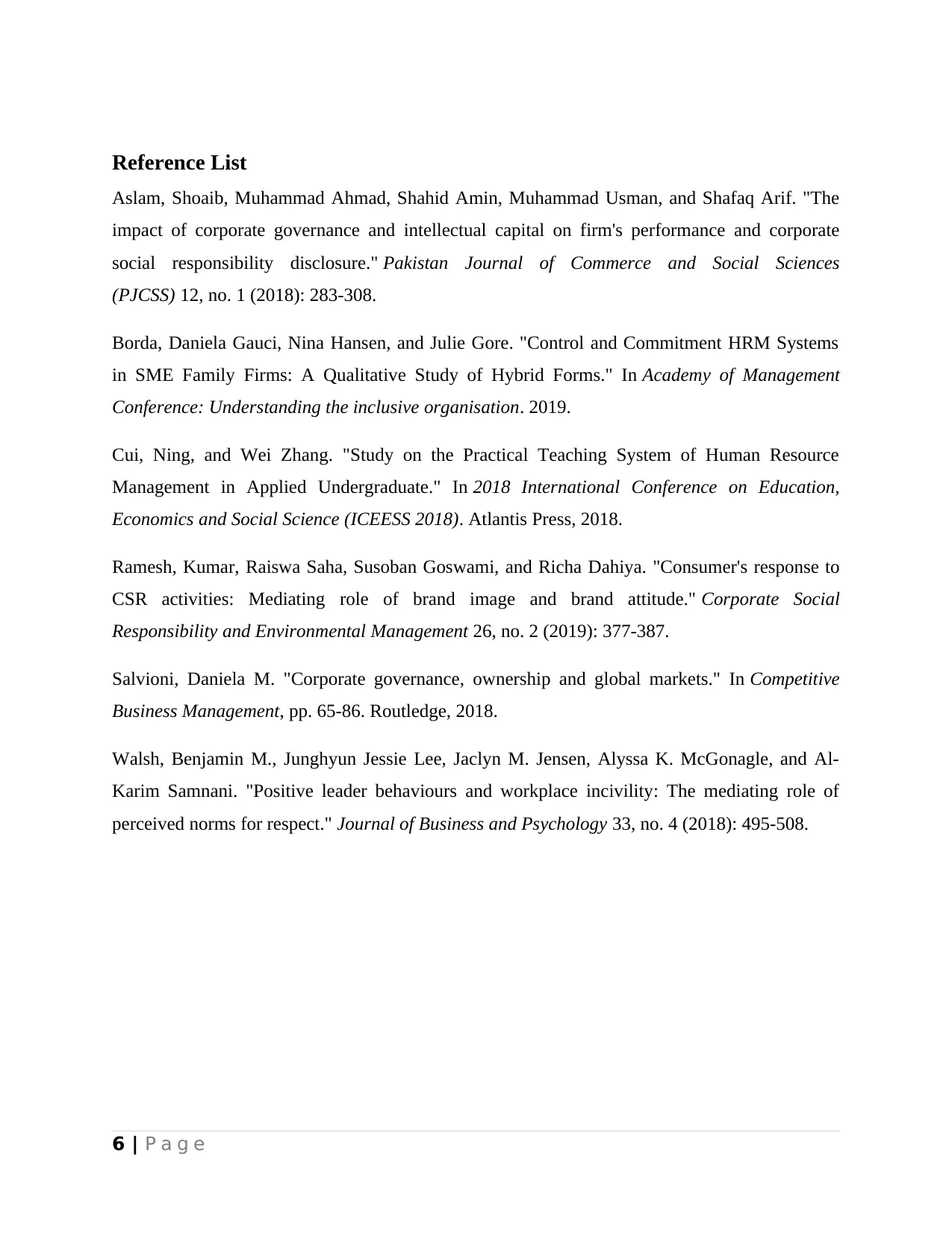
Reference List
Aslam, Shoaib, Muhammad Ahmad, Shahid Amin, Muhammad Usman, and Shafaq Arif. "The
impact of corporate governance and intellectual capital on firm's performance and corporate
social responsibility disclosure." Pakistan Journal of Commerce and Social Sciences
(PJCSS) 12, no. 1 (2018): 283-308.
Borda, Daniela Gauci, Nina Hansen, and Julie Gore. "Control and Commitment HRM Systems
in SME Family Firms: A Qualitative Study of Hybrid Forms." In Academy of Management
Conference: Understanding the inclusive organisation. 2019.
Cui, Ning, and Wei Zhang. "Study on the Practical Teaching System of Human Resource
Management in Applied Undergraduate." In 2018 International Conference on Education,
Economics and Social Science (ICEESS 2018). Atlantis Press, 2018.
Ramesh, Kumar, Raiswa Saha, Susoban Goswami, and Richa Dahiya. "Consumer's response to
CSR activities: Mediating role of brand image and brand attitude." Corporate Social
Responsibility and Environmental Management 26, no. 2 (2019): 377-387.
Salvioni, Daniela M. "Corporate governance, ownership and global markets." In Competitive
Business Management, pp. 65-86. Routledge, 2018.
Walsh, Benjamin M., Junghyun Jessie Lee, Jaclyn M. Jensen, Alyssa K. McGonagle, and Al-
Karim Samnani. "Positive leader behaviours and workplace incivility: The mediating role of
perceived norms for respect." Journal of Business and Psychology 33, no. 4 (2018): 495-508.
6 | P a g e
Aslam, Shoaib, Muhammad Ahmad, Shahid Amin, Muhammad Usman, and Shafaq Arif. "The
impact of corporate governance and intellectual capital on firm's performance and corporate
social responsibility disclosure." Pakistan Journal of Commerce and Social Sciences
(PJCSS) 12, no. 1 (2018): 283-308.
Borda, Daniela Gauci, Nina Hansen, and Julie Gore. "Control and Commitment HRM Systems
in SME Family Firms: A Qualitative Study of Hybrid Forms." In Academy of Management
Conference: Understanding the inclusive organisation. 2019.
Cui, Ning, and Wei Zhang. "Study on the Practical Teaching System of Human Resource
Management in Applied Undergraduate." In 2018 International Conference on Education,
Economics and Social Science (ICEESS 2018). Atlantis Press, 2018.
Ramesh, Kumar, Raiswa Saha, Susoban Goswami, and Richa Dahiya. "Consumer's response to
CSR activities: Mediating role of brand image and brand attitude." Corporate Social
Responsibility and Environmental Management 26, no. 2 (2019): 377-387.
Salvioni, Daniela M. "Corporate governance, ownership and global markets." In Competitive
Business Management, pp. 65-86. Routledge, 2018.
Walsh, Benjamin M., Junghyun Jessie Lee, Jaclyn M. Jensen, Alyssa K. McGonagle, and Al-
Karim Samnani. "Positive leader behaviours and workplace incivility: The mediating role of
perceived norms for respect." Journal of Business and Psychology 33, no. 4 (2018): 495-508.
6 | P a g e
⊘ This is a preview!⊘
Do you want full access?
Subscribe today to unlock all pages.

Trusted by 1+ million students worldwide
1 out of 6
Related Documents
Your All-in-One AI-Powered Toolkit for Academic Success.
+13062052269
info@desklib.com
Available 24*7 on WhatsApp / Email
![[object Object]](/_next/static/media/star-bottom.7253800d.svg)
Unlock your academic potential
Copyright © 2020–2025 A2Z Services. All Rights Reserved. Developed and managed by ZUCOL.





